How to keep your Toyota in TOYOTA YARIS iA 2017 Owners Manual (in English)
[x] Cancel search | Manufacturer: TOYOTA, Model Year: 2017, Model line: YARIS iA, Model: TOYOTA YARIS iA 2017Pages: 576, PDF Size: 8.9 MB
Page 1 of 576
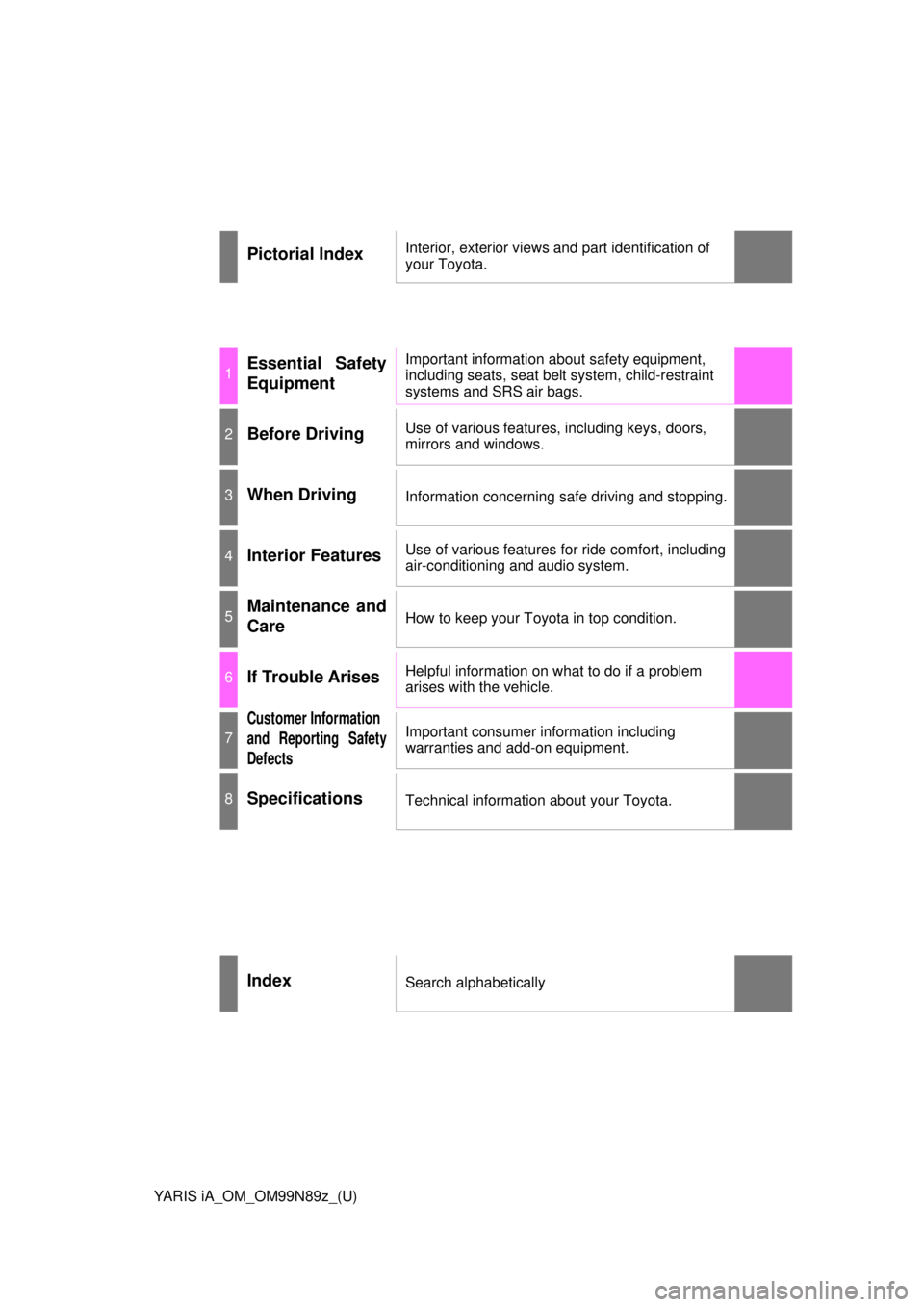
YARIS iA_OM_OM99N89z_(U)
Pictorial IndexInterior, exterior views and part identification of
your Toyota.
1Essential Safety
EquipmentImportant information about safety equipment,
including seats, seat belt system, child-restraint
systems and SRS air bags.
2Before DrivingUse of various features, including keys, doors,
mirrors and windows.
3When DrivingInformation concerning safe driving and stopping.
4Interior FeaturesUse of various features for ride comfort, including
air-conditioning and audio system.
5Maintenance and
CareHow to keep your Toyota in top condition.
6If Trouble ArisesHelpful information on what to do if a problem
arises with the vehicle.
7
Customer Information
and Reporting Safety
DefectsImportant consumer information including
warranties and add-on equipment.
8SpecificationsTechnical information about your Toyota.
IndexSearch alphabetically
Page 30 of 576
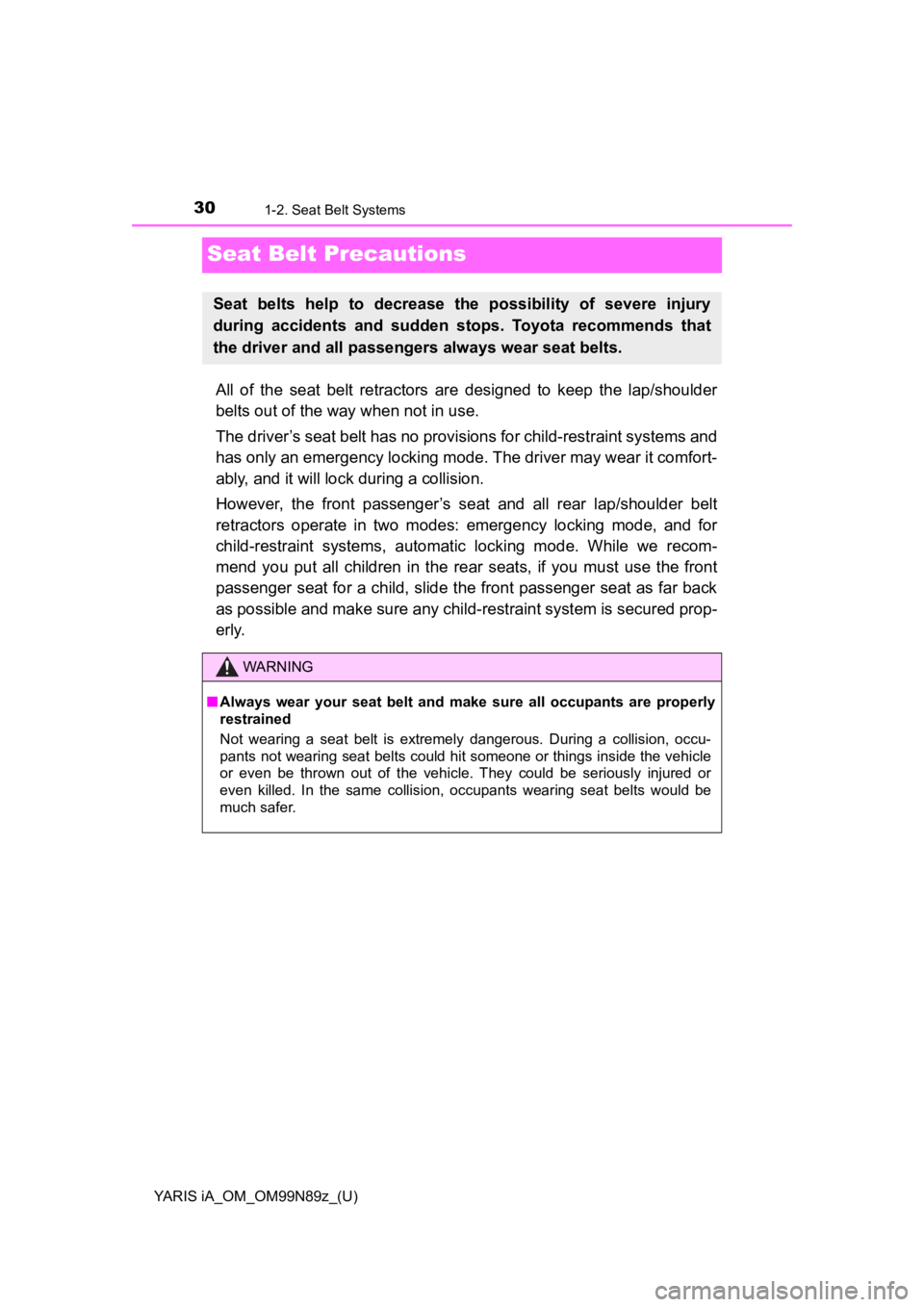
30
YARIS iA_OM_OM99N89z_(U)
1-2. Seat Belt Systems
Seat Belt Precautions
All of the seat belt retractors are designed to keep the lap/shoulder
belts out of the way when not in use.
The driver’s seat belt has no provisions for child-rest raint systems and
has only an emergency locking mode. The driver may wear it comfort-
ably, and it will lock during a collision.
However, the front passenger’s seat and all rear lap/shoulder belt
retractors operate in two modes: emergency locking mode, and for
child-restraint systems, automatic locking mode. While we recom-
mend you put all children in the rear seats, if you must use the front
passenger seat for a child, slide t he front passenger seat as far back
as possible and make sure any child-restraint system is secured prop-
erly.
Seat belts help to decrease the possibility of severe injury
during accidents and sudden stops. Toyota recommends that
the driver and all passengers always wear seat belts.
WARNING
■ Always wear your seat belt and make sure all occupants are properly
restrained
Not wearing a seat belt is extremely dangerous. During a collision, occu-
pants not wearing seat belts could hit someone or things inside the vehicle
or even be thrown out of the vehicle. They could be seriously injured or
even killed. In the same collision, occupants wearing seat belts would be
much safer.
Page 42 of 576
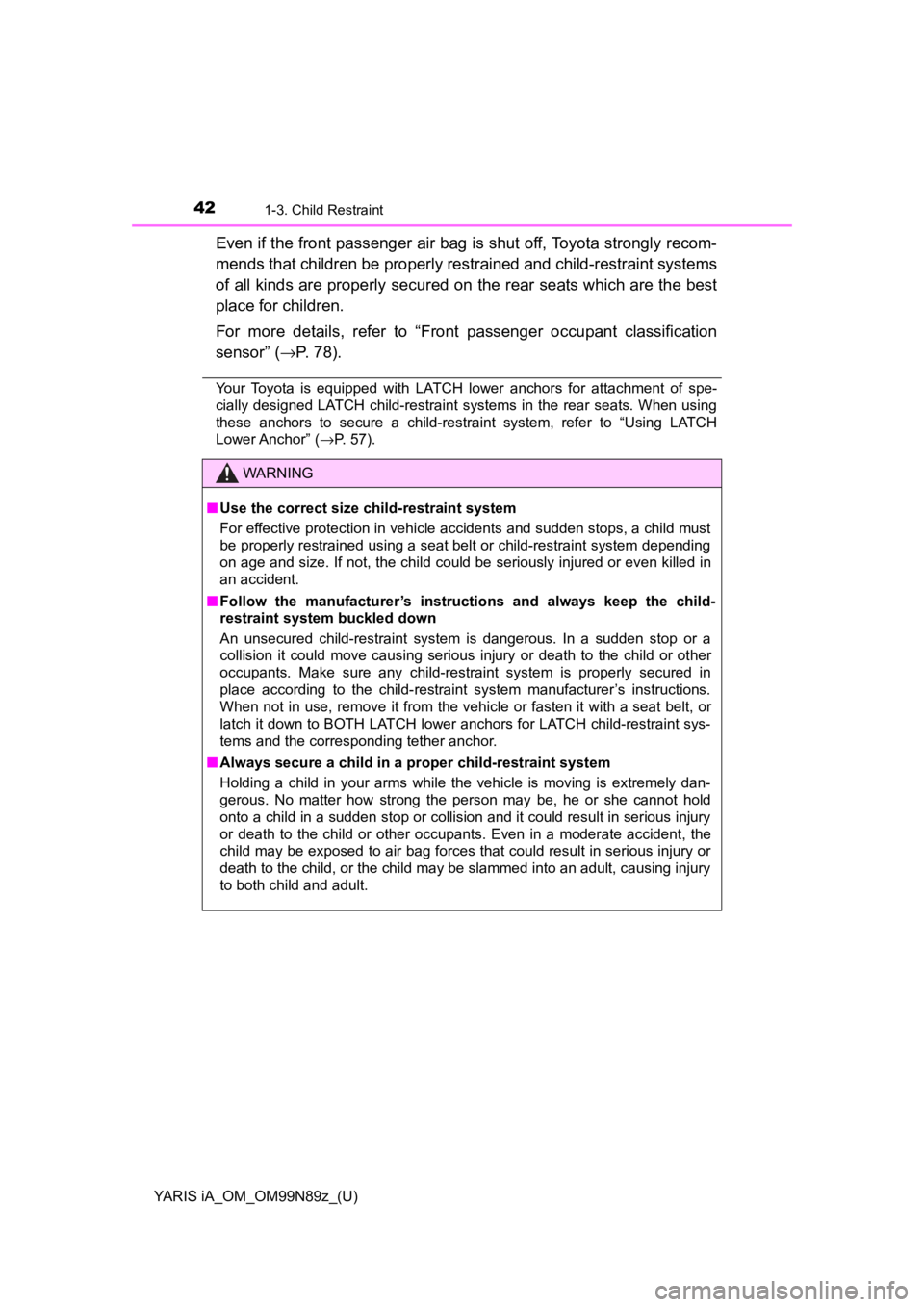
42
YARIS iA_OM_OM99N89z_(U)
1-3. Child Restraint
Even if the front passenger air bag is shut off, Toyota strongly recom-
mends that children be properly restrained and child-restraint systems
of all kinds are properly secured on the rear seats which are the best
place for children.
For more details, refer to “Front passenger occupant classification
sensor” ( →P. 78).
Your Toyota is equipped with LATCH lower anchors for attachment of spe-
cially designed LATCH child-restraint systems in the rear seats. When using
these anchors to secure a child-restraint system, refer to “Using LATCH
Lower Anchor” (→P. 57).
WARNING
■Use the correct size child-restraint system
For effective protection in vehicle accidents and sudden stops, a child must
be properly restrained using a seat belt or child-restraint system depending
on age and size. If not, the child could be seriously injured or even killed in
an accident.
■ Follow the manufacturer’s instructions and always keep the child-
restraint system buckled down
An unsecured child-restraint system is dangerous. In a sudden stop or a
collision it could move causing serious injury or death to the child or other
occupants. Make sure any child-restraint system is properly secured in
place according to the child-restraint system manufacturer’s instructions.
When not in use, remove it from the vehicle or fasten it with a seat belt, or
latch it down to BOTH LATCH lower anchors for LATCH child-restraint sys-
tems and the corresponding tether anchor.
■ Always secure a child in a proper child-restraint system
Holding a child in your arms while the vehicle is moving is extremely dan-
gerous. No matter how strong the person may be, he or she cannot hold
onto a child in a sudden stop or collision and it could result in serious injury
or death to the child or other occupants. Even in a moderate accident, the
child may be exposed to air bag forces that could result in serious injury or
death to the child, or the child may be slammed into an adult, causing injury
to both child and adult.
Page 127 of 576
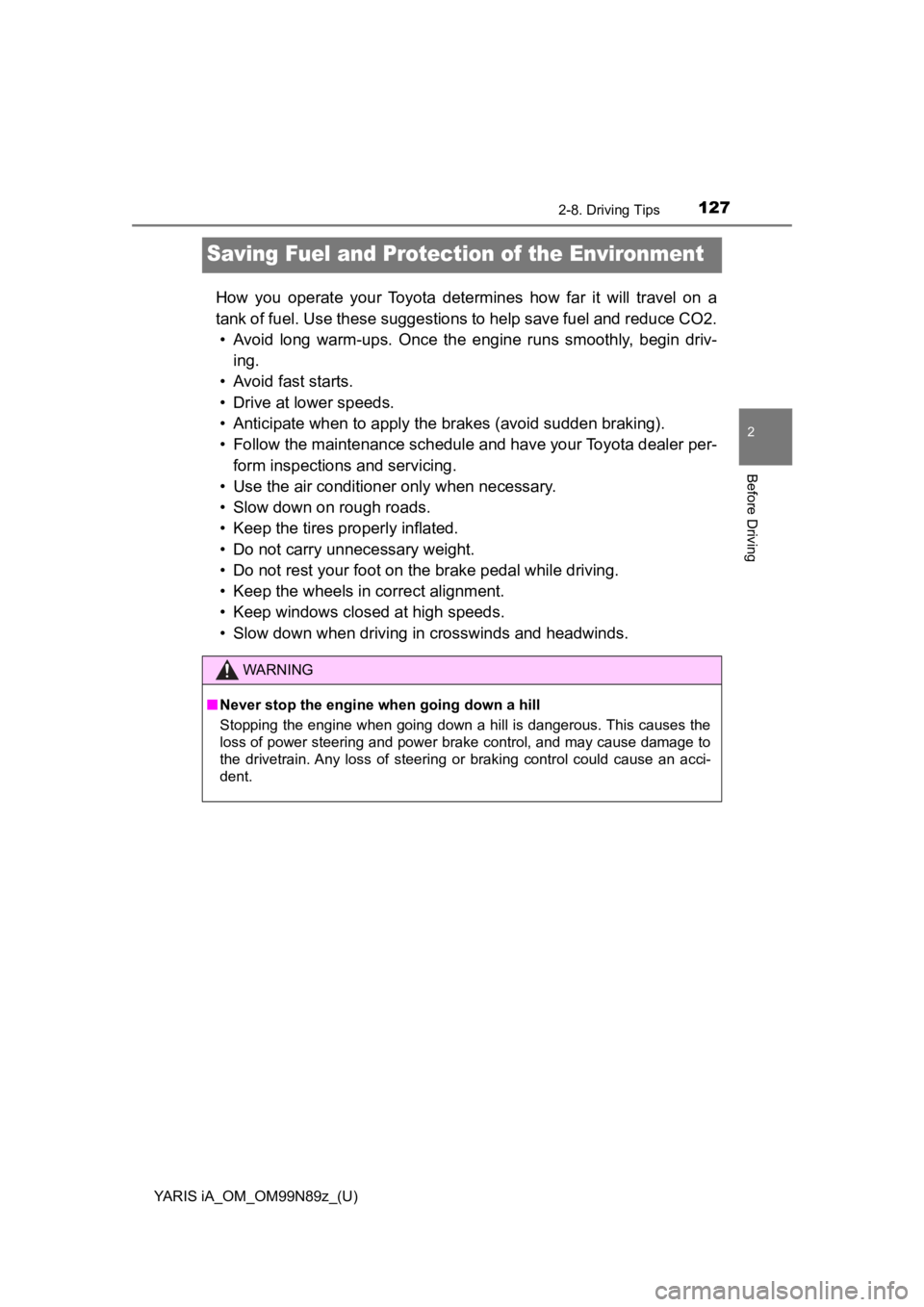
127
YARIS iA_OM_OM99N89z_(U)
2-8. Driving Tips
2
Before Driving
Saving Fuel and Protection of the Environment
How you operate your Toyota determines how far it will travel on a
tank of fuel. Use these suggestions to help save fuel and reduce CO2.
• Avoid long warm-ups. Once the en gine runs smoothly, begin driv-
ing.
• Avoid fast starts.
• Drive at lower speeds.
• Anticipate when to apply the brakes (avoid sudden braking).
• Follow the maintenance schedule and have your Toyota dealer per- form inspections and servicing.
• Use the air conditioner only when necessary.
• Slow down on rough roads.
• Keep the tires properly inflated.
• Do not carry unnecessary weight.
• Do not rest your foot on the brake pedal while driving.
• Keep the wheels in correct alignment.
• Keep windows closed at high speeds.
• Slow down when driving in crosswinds and headwinds.
WARNING
■ Never stop the engine when going down a hill
Stopping the engine when going down a hill is dangerous. This causes the
loss of power steering and power brake control, and may cause damage to
the drivetrain. Any loss of steering or braking control could cause an acci-
dent.
Page 412 of 576

412
YARIS iA_OM_OM99N89z_(U)
5-1. Essential Information
Introduction
Be extremely careful and prevent injury to yourself and others or dam-
age to your vehicle when using this manual for inspection and mainte-
nance.
If you are unsure about any procedure it describes, we strongly urge
you to have a reliable and qualified service shop perform the work,
preferably your Toyota dealer.
Factory-trained Toyota technicians and genuine Toyota parts are best
for your vehicle. Without this expe rtise and the parts that have been
designed and made especially for your Toyota, inadequate, incom-
plete, and insufficient servicing may result in problems. This could
lead to vehicle damage or an accident and injuries.
For expert advice and quality service, consult your Toyota dealer.
To continue warranty eligibility and to protect your investment, it is
your responsibility to pr operly maintain your vehicle according to fac-
tory recommended schedul es outlined in this manual. Keep a copy of
the repair order. It proves that the maintenance that has been per-
formed is under warranty coverage. If any problem should arise while
your vehicle is under warranty, your Toyota dealer will promptly take
care of it.
This evidence may consist of the following: • The Maintenance Log, found within the Warranty and Maintenance Guide, must be completely filled out showing mileage, repair order
number, date for each service, and signed by a qualified automotive
service technician who service vehicles.
• Original copies of repair orders or other receipts that include the mileage and date the vehicle was serviced. Each receipt should be
signed by a qualified automot ive service technician.
• For self maintenance, a statemen t that you completed the mainte-
nance yourself, displaying mileag e and the date the work was per-
formed. Also, receipts for the replac ement parts (fluid, filters, etc.)
indicating the date and mileage mu st accompany this statement.
Page 463 of 576

YARIS iA_OM_OM99N89z_(U)
4635-4. Appearance Care
5
Maintenance and Care
●Prevention
It is necessary to have your Toyota washed and waxed to pre-
serve its finish according to the in structions in this section. This
should be done as soon as possible.
Bird droppings can be removed with a soft sponge and water. If
you are traveling and these are not available, a moistened tissue
may also take care of the problem. The cleaned area should be
waxed according to the inst ructions in this section.
Insects and tree sap are best removed with a soft sponge and
water or a commercially available chemical cleaner.
Another method is to cover the affected area with dampened
newspaper for one to two hours. After removing the newspaper,
rinse off the loosened debris with water.
■Water Marks
● Occurrence
Rain, fog, dew, and even tap water can contain harmful minerals
such as salt and lime. If mois ture containing these minerals set-
tles on the vehicle and evapor ates, the minerals will concentrate
and harden to form white rings. The rings can damage your vehi-
cle’s finish.
● Prevention
It is necessary to wash and wax your vehicle to preserve its finish
according to the instructions in this section. These steps should
be taken immediately after you find water marks on your vehi-
cle’s finish.
■Paint Chipping
● Occurrence
Paint chipping occurs when gravel thrown in the air by another
vehicle’s tires hits your vehicle.
● How to avoid paint chipping
Keeping a safe distance between you and the vehicle ahead
reduces the chances of having your paint chipped by flying
gravel.
Follow all label and container directions when using a chemical
cleaner or polish. Read all warnings and cautions.
Page 464 of 576
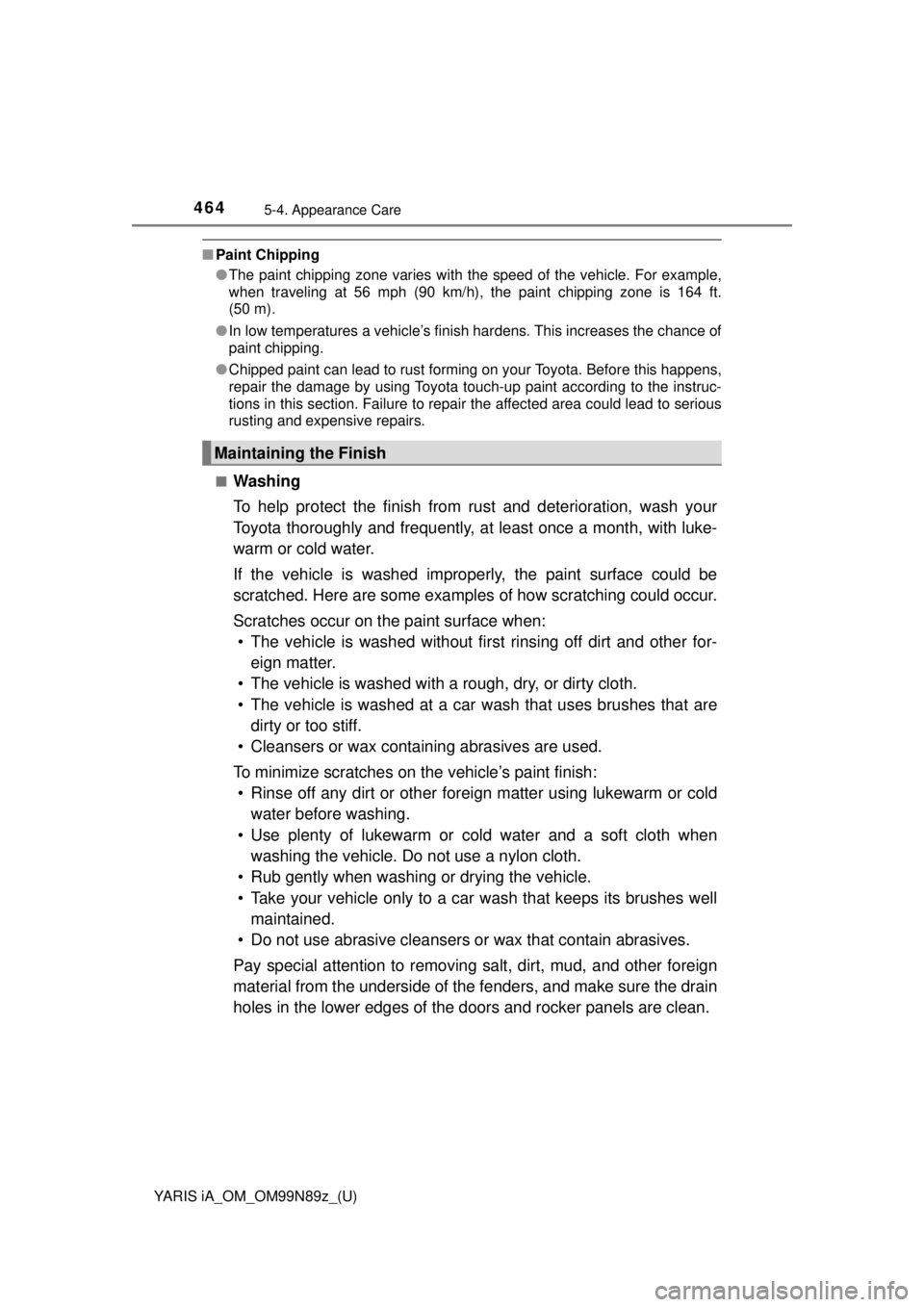
4645-4. Appearance Care
YARIS iA_OM_OM99N89z_(U)
■Paint Chipping
●The paint chipping zone varies with the speed of the vehicle. For example,
when traveling at 56 mph (90 km/h), the paint chipping zone is 164 ft.
(50 m).
● In low temperatures a vehicle’s finish hardens. This increases the chance of
paint chipping.
● Chipped paint can lead to rust forming on your Toyota. Before this happens,
repair the damage by using Toyota touch-up paint according to the instruc-
tions in this section. Failure to repair the affected area could lead to serious
rusting and expensive repairs.
■
Washing
To help protect the finish from rust and deterioration, wash your
Toyota thoroughly and frequently, at least once a month, with luke-
warm or cold water.
If the vehicle is washed impro perly, the paint surface could be
scratched. Here are some examples of how scratching could occur.
Scratches occur on the paint surface when: • The vehicle is washed without fi rst rinsing off dirt and other for-
eign matter.
• The vehicle is washed with a rough, dry, or dirty cloth.
• The vehicle is washed at a car wash that uses brushes that are
dirty or too stiff.
• Cleansers or wax containing abrasives are used.
To minimize scratches on the vehicle’s paint finish: • Rinse off any dirt or other foreign matter using lukewarm or cold water before washing.
• Use plenty of lukewarm or cold water and a soft cloth when washing the vehicle. Do not use a nylon cloth.
• Rub gently when washing or drying the vehicle.
• Take your vehicle only to a car wash that keeps its brushes well maintained.
• Do not use abrasive cleansers or wax that contain abrasives.
Pay special attention to removing salt, dirt, mud, and other foreign
material from the underside of the fenders, and make sure the drain
holes in the lower edges of the doors and rocker panels are clean.
Maintaining the Finish